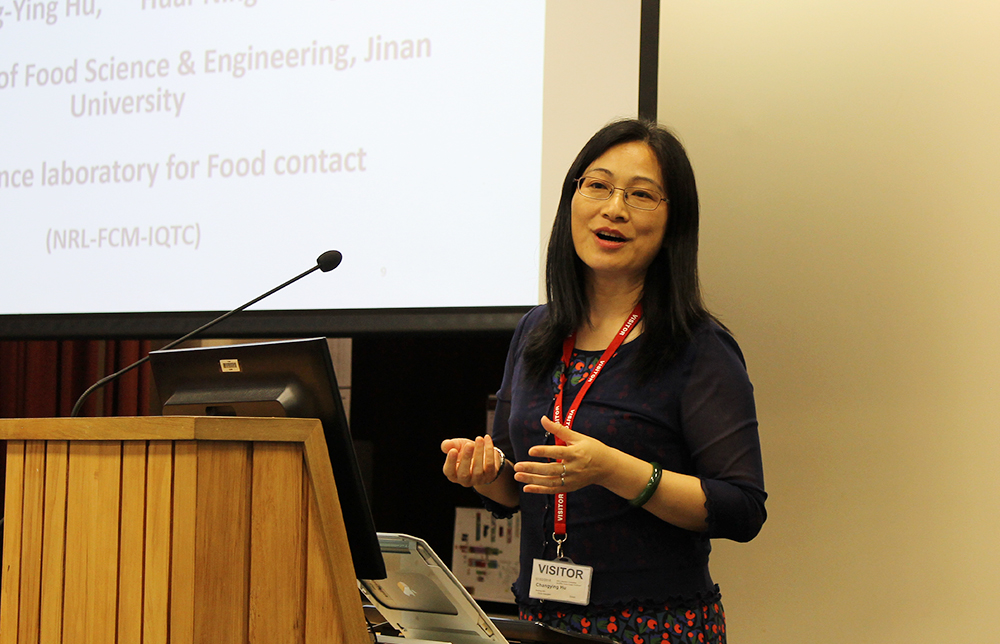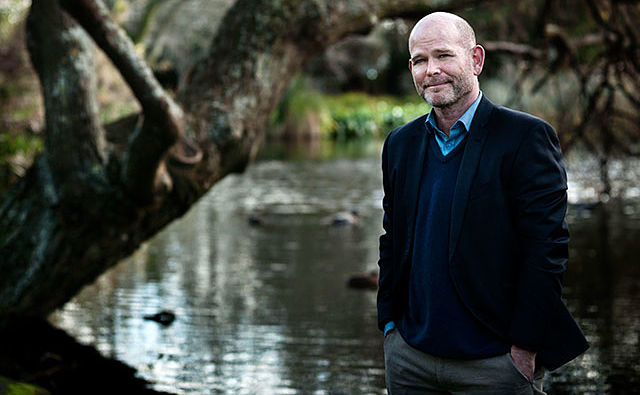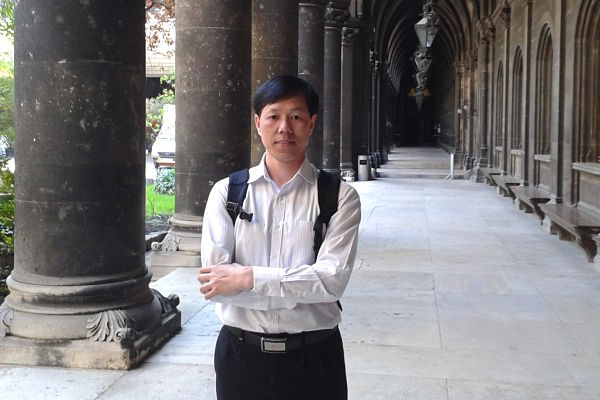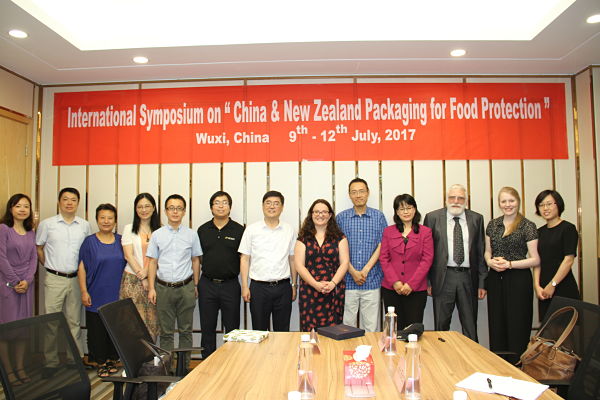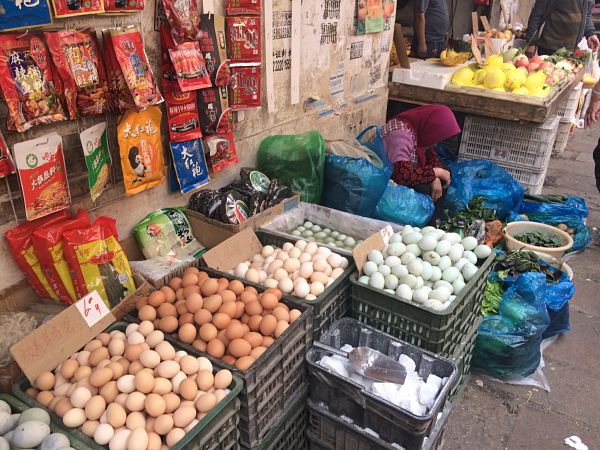At the beginning of February 2018 Professor Changying Hu from the College of Science and Engineering (Jinan University) visited New Zealand to take part in a scientist exchange funded by the New Zealand China Food Protection Network (NZCFPN). The aim of this scientist exchange between Jinan University (China) and Scion (New Zealand) is to establish a platform for ongoing knowledge exchange in the area of packaging food contact compliance. As part of her visit, Professor Hu gave a seminar on Chinese food contact requirements to interested parties from industry and research at Scion on February 12th. The aim of the seminar was to improve understanding of the new Chinese Food Contact Regulations, as well as establishing contacts with Chinese research organisations and testing laboratories. Overall around 50 people attended the seminar.
Category: Food Protection News
Congratulations, Distinguished Professor Nigel French
It is a huge pleasure to announce that Nigel has been awarded the title of Distinguished Professor, which is the highest honour Massey University can bestow on a member of its academic staff and reflects the importance it places on the work and achievement of the recipients.
This is a richly deserved award. I introduced Nigel as a keynote speaker last year and took time to reflect on and appreciate the vision that he has, his ability to start up and grow successful groups that provide great opportunities for others, and his mentoring of staff and students.
Associate Professor Jackie Benschop
To view the article from the Massey Newsletter click here
Antimicrobial resistance and antimicrobial usage in New Zealand and China, with particular reference to the dairy value chain
Brief summary of recent highlights from NZCFPN-seed project:
‘Antimicrobial resistance and antimicrobial usage in New Zealand and China, with particular reference to the dairy value chain’
Dr Adrian Cookson (AgResearch Ltd) and Dr Sara Burgess (Massey University)
A workshop in support of the NZCFPN project ‘Antimicrobial resistance and antimicrobial usage in New Zealand and China, with particular reference to the dairy value chain’ was held in Beijing, China on 27 and 28 November 2017. It was hosted by Professor Shuntang Guo (China Agriculture University) and Professor Nigel French (NZFSSRC) and was attended by 27 university and industry experts in the area of antimicrobial research (AMR) and antimicrobial use (AMU). Presentations covered a number of broad AMR/AMU research areas relating to the respective NZ and China animal production systems, human health, national surveillance strategies and action plans, together with research on antibiotic-free feed strategies and methods for the detection of antibiotics in animal feed. China research institutes and dairy companies represented included China Agricultural University, Chinese Academy of Agricultural Sciences, Zhejiang University, COFCO NHRI, Fonterra, Mongolia Yili Industrial Group Co., Ltd., China Mengniu Dairy Co., Ltd., New Hope Dairy Co., Ltd., and Sanyuan Group. New Zealand research institutes and dairy companies represented included, AgResearch Ltd., Massey University, Cognosco, NZFSSRC and Fonterra. New Zealand Governments represented were MBIE and MFAT. Further directions are aimed at further developing NZ-China relationships in the AMR/AMU area with research staff exchanges between institutes.
A Long Way from Beijing
An immediate outcome of the Centre’s visit to China in April was the arrangement for food scientist Dr Lishui Chen to spend a year at NZFSSRC in Palmerston North. Lishui arrived in July. His travel is funded by the NZ China Food Protection Network, and salary paid by his employer COFCO, China’s largest food processor, manufacturer and marketer. He works for their Nutrition Health Research Institute in Beijing.
Lishui’s rather daunting task is to update a comprehensive report on the food safety and security landscape in China and NZ. He will compare food regulations, particularly those relating to dairy and meat products. His roadmap of such a large and unfamiliar system, and his recommendations for NZ exporters, will be invaluable.
Lishui is helping Dr Adrian Cookson of AgResearch Ltd, a principal contributor to the Centre, organise a workshop on antimicrobial resistance, at China Agricultural University, in Beijing this November.
His research interests include functional foods and macrobiotics, in addition to food safety. His PhD from Harbin Institute of Technology was on probiotics, which are a multi-billion dollar market in China. Lishui will be talking to scientists in NZ from the Riddet Institute and other Institutes during his stay. COFCO has up to the minute facilities to test new functional foods and consumer response to them. Lishui’s R&D work has included functional foods for older people, dietary supplements for pregnant women*, and raw milk derivatives. Ultimately, mass market response to new foods is measured from sales through the COFCO company’s 7 shopping malls, called Joy City.
Chinese diets have been changing very rapidly. Instant noodles, western foods and take-away chains, have become the norm in the big cities. However, there is considerable regional variation. In Lishui’s home province of Hunan in central southern China, “hot and spicy” sums it up. Chillies of every description open the pores and help you cool down in the humid summers.
Lishui is enjoying the change to the cool, fresh climate and landscape of less populous Manawatu. He even gets the weekends off.
*On 18 October, it was announced that a study funded by Fonterra and the Health Research Council, conducted by Auckland and Otago Universities, showed that a probiotic derived from fermented dairy product (Lactobacillus rhamnousus HN001), taken during pregnancy, can prevent postnatal depression.
NZ China Food Protection Network – Packaging for food safety and security
Scion and Otago University joined forces and combined their respective expertise in packaging and consumer perception to establish new relationships with Chinese packaging researchers and manufacturers. With funding from the New Zealand China Food Protection Network, representatives from the organizations travelled to China to host a workshop specifically on packaging for food protection and to visit local players in the packaging industry.
Lou Sherman, Packaging Research Leader at Scion says packaging is an integral part of most food products, especially those that are exported. In a New Zealand context, packaging supports the export of more than one billion dollars’ worth of goods through containment, protection and communication.
“As part of its protection role, packaging has a huge impact on the safety and security of food,” says Lou. “There are many opportunities to develop new packaging that is better able to protect the food inside, but we find consumer acceptance and meeting regulatory requirements in foreign markets is a big barrier to introducing new packaging solutions. To overcome these and future market barriers we want to establish a partnership between New Zealand and Chinese researchers to help the development and uptake of innovative packaging solutions.”
The workshop was held at Jiangnan with attendees from Tianjin University of Science & Technology, Jinan University and University of Auckland. Some local school students saw the workshop advertised online and attended as they are interested to learn more about international packaging research. The workshop was also watched via Zoom by five participants back in New Zealand. Topics of joint interest including food contact safety, antimicrobial packaging, sustainable materials and smart packaging were discussed. We are now actively seeking opportunities to fund future New Zealand and Chinese collaborations on this space.
Contact: Lou Sherman, Scion; email lou.sherman@scionresearch.com
(SAFE) FOOD RECOVERY – Dr Miranda Mirosa, University of Otago
We have become painfully aware of the astonishing amount of food waste. Between 30 and 50%! Think of those browning other-half avocados, the last few slices of mouldy bread, the left over spinach quietly turning to slime in the bottom of the chiller, the mad ill-considered dashes around the supermarket after work. And then there is the past use-by-date food necessarily jettisoned by restaurants and supermarkets. None of these businesses want to waste food. Why would they throw money in the bin? It’s just hard to perfectly anticipate demand.
Think of all the wasted water, fertiliser, packaging and fuel it takes to produce that binned food. Not to mention the human effort involved.
Research suggests that household food waste is the largest component, averaging an estimated loss of $550 per household per year in New Zealand. The waste ends up rotting in landfills.
University of Otago consumer food scientist, Dr Miranda Mirosa, her colleagues, students and legions of energetic, entrepreneurial New Zealanders, to the rescue.
Miranda describes herself as “an interdisciplinarian with a background in marketing and consumer behaviour. My research aims to understand why people eat what they do, why they don’t eat what they don’t, and how we might best impact upon these choices to encourage people to choose quality, healthy and environmentally sustainable foods.”
She is currently involved in the WasteMINZ (the representative body of the waste and resource recovery sector in New Zealand) National Consumer Food Waste Reduction project and the Love Food Hate Waste campaign to reduce household food waste.
Miranda established the University of Otago Food Waste Innovation Research Group, which brings together social and pure scientists to discuss the challenges surrounding food waste and how to solve them.
There are many inspiring food recovery initiatives cropping up around New Zealand. For example, a group of volunteers in Wellington collect left-over food from restaurants and distribute it to anyone who wants it – no questions asked – from a converted shipping container in the grounds of St Peter’s Church in Willis St. https://www.thefreestore.org.nz/ These inspiring initiatives are directly helping to mitigate climate change, as well as poverty.
Miranda says a change to legislation (The Food Act 2014) means that restaurants can now readily donate left-over food without worry over liability, provided it is in good condition when it leaves their premises. That has removed a significant impediment. Food safety is the prime consideration for any food recovery group. It is incumbent on these groups to ensure safe handling practices. In Miranda’s experience, they have sophisticated protocols and intensive staff induction training, and she is not aware of any problems.
Apart from food recovery issues, Miranda’s group are investigating ways of using waste products like fruit peelings and perfectly healthy, but not very pretty, fruit and vegetables rejected by consumers. For example, they can be made into juices.
They have also organised public cooking demonstrations by “Supergrans”, who are old to enough to remember a time when food was not so cheap or readily available. They show students and recipients of rescued food how to make “something out of nothing”.
Miranda is the Otago lead for the NZ China Food Protection Network, allied to NZFSSRC. She is spending a lot of time in China and Taiwan on an APEC funded project to assess food loss and waste throughout the supply chain, and to respond with policy recommendations.
Food safety is the most important consideration for Chinese consumers. Understandably, there is heightened sensibility after some serious food contamination incidents. Miranda wants to help New Zealand exporters understand what cues Chinese consumers respond favourably to, e.g. guarantees of traceability, values associated with the country of origin, imagery, wording, and attitudes to food processing techniques such as irradiation.
The Chinese students in the Otago Research Group help give local researchers an insight into Chinese attitudes, customs and practices.
Miranda was a member of a recent science mission to China, where she and her colleagues made useful connections with social scientists at Xian Jiaotong Liverpool University, who have common interests in consumer perceptions and behaviour.
Returning to the more immediate, local problem of that other half of the avocado, Miranda advises keeping the stone in and wrapping it straight away with cling film. She has the research to back it up!
Massey-hosted food safety partnership awarded $1.25M
A new partnership involving nine New Zealand research organisations has been awarded $1.25 million in funding from the Ministry of Business, Innovation and Employment.
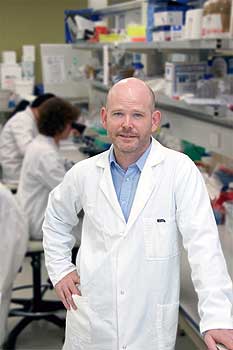
The New Zealand-China Food Protection Network (NZ-CFPN) will enhance communication between research scientists, government organisations and industries here and in China. This network will work alongside the recently announced New Zealand Food Safety Science and Research Centre, which has Massey Professor Nigel French as its establishment director.
The partners in the NZ-CFPN are from across leading universities, Crown Research Institutes and the Cawthron Institute. Over the years, they have developed ongoing research collaborations in food safety and security with 51 Chinese partners, including 13 of the top 50-ranked universities in China and other leading Chinese academies.
Project leader Professor Nigel French says these collaborations have evolved through individual organisations and scientists pairing with Chinese partners.
“The Network will create a new mechanism for knowledge generation and exchange, enabling the uptake of research into effective policies that reduce hazards in the food chain and ensure a sustainable supply of safe and nutritious food.
“It will increase consumer confidence in both countries, ensuring international best practice is being followed for food protection. The network will be highly connected, effective and durable, and will help transform the food safety and security research landscape,” says Professor French.
Professor French says the NZ-CFPN will take a New Zealand Inc approach. “It will effectively ‘rewire’ the existing network to create additional, enduring partnerships between New Zealand and leading Chinese research organisations. This will establish new relationships, facilitate knowledge exchange and create new opportunities for acquiring significant international funding in key areas of importance for food safety and security in both countries.”
The other New Zealand partners involved in the project are:
University of Auckland
Organisation Lead: Dr Frederique Vanholsbeeck
University of Otago
Organisation Lead: Professor Phil Bremer
Auckland University of Technology
Organisation Lead: Dr Brent Seale
Cawthron Institute
Organisation Lead: Dr Robert Matheson
AgResearch
Organisation Lead: Dr Gale Brightwell
Environmental Science & Research
Organisation Lead: Dr Rob Lake
Plant & Food Research
Organisation Lead: Mr Graham Fletcher
Scion
Organisation Lead: Ms Lou Sherman
The projects aims will be achieved through a five-year programme of scientist and postgraduate exchanges, conferences and workshops, seed funding for strategic projects and the development of a dedicated website and communication platform. The NZ-CFPN will be an inclusive network available to all research providers and industries in both countries.

